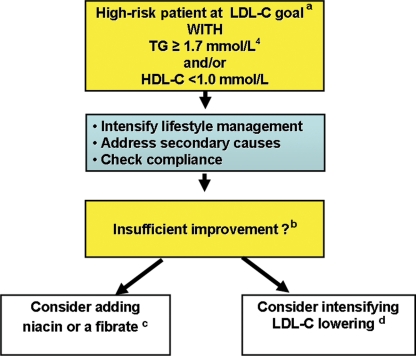Figure 6.
Proposed algorithm for the management of high-risk individuals with elevated triglycerides and/or low HDL cholesterol at LDL cholesterol goal. aLDL-C at goal as recommended by the most recent European guidelines (2007);4 <2.5 mmol/L in high-risk patients, decreasing to <2.0 mmol/L in very high risk patients. High-dose omega-3 fatty acids, fibrate, or niacin may be considered if the patient has very high TG (>5.0 mmol/L) to prevent pancreatitis. bIf the patient still has elevated TG (≥1.7 mmol/L, as recommended by the most recent European guidelines4) and/or low HDL-C (<1.0 mmol/L) despite intensive lifestyle intervention, and addressing compliance with pharmacotherapy and secondary causes of dyslipidaemia, additional lipid-modifying therapy may be considered. cBased on clinical outcome data and safety considerations for combination statin–fibrate therapy, fenofibrate is the preferred fibrate. This fibrate may have particular value in patients with T2DM and mild-to-moderate retinopathy. dGreater LDL-C lowering may be achieved by the addition of ezetimibe to a statin. Ezetimibe has a dose-sparing advantage in patients intolerant of higher dose statins, although outcome evidence to support its use is awaited. Note: To convert LDL-C or HDL-C from mmol/L to mg/dL multiply by 38.7; to convert TG from mmol/L to mg/dL multiply by 88.5. Abbreviations: TG, triglycerides; HDL-C, high-density-lipoprotein cholesterol; LDL-C, low-density-lipoprotein cholesterol.

